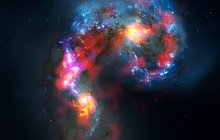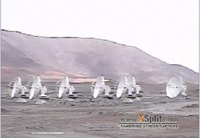ALMA
Alla ricerca delle nostre origini cosmiche
Cos'è ALMA?
Sull'altopiano di Chajnantor nelle Ande cilene, l'ESO (European Southern Observatory), in collaborazione con i suoi partner internazionali, gestisce ALMA — (Atacama Large Millimeter/submillimeter Array ) - un telescopio modernissimo per studiare la luce proveniente da alcuni dei più freddi oggetti dell'Universo. Questa luce ha lunghezze d'onda di circa un millimetro, fra la luce infrarossa e le onde radio, ed è perciò conosciuta come radiazione millimetrica e submillimetrica. ALMA è composta da 66 antenne di alta precisione, disseminate a distanze che raggiungono i 16 chilometri. Questa collaborazione globale è il più grande progetto per un telescopio astronomico a terra attualmente in corso.
Cos'è l'astronomia submillimetrica?
La luce a queste lunghezze d'onda proviene da vaste nubi fredde nello spazio interstellare, a temperature di solo alcune decine di gradi sopra lo zero assoluto, e da alcune tra le più antiche e distanti galassie dell'Universo. Gli astronomi possono usarla per studiare le condizioni chimiche e fisiche nelle nubi molecolari – le dense regioni di gas e polvere dove nascono nuove stelle. Spesso, queste regioni dell'Universo sono buie e oscure se guardate nella luce visibile, ma appaiono brillanti nella parte dello spettro millimetrica e submillimetrica.
Perchè costruire ALMA nelle Ande?
La radiazione millimetrica e submillimetrica apre una finestra sull'enigmatico Universo freddo, ma i segnali provenienti dallo spazio sono fortemente assorbiti dal vapore acqueo presente nell'atmosfera terrestre. Per questo i telescopi per questo tipo di astronomia devono essere costruiti in siti elevati e secchi, come quello di 5000 metri dell'altopiano di Chajnantor, il sito del più alto osservatorio astronomico sulla Terra.
Il sito di ALMA, circa 50 kilometri a est di San Pedro di Atacama, nel nord del Cile, è uno dei luoghi più secchi della Terra. Gli astronomi vi trovano condizioni ineguagliabili per l'osservazione, ma devono gestire un osservatorio di frontiera in condizioni molto difficili. Il Chajnantor è 750 m più in alto dell'Osservatorio di Mauna Kea, e 2400 metri più in alto del VLT sul Cerro Paranal.
Visita della Piana di Chajnantor
Click on the image to take a Virtual Tour in and nearby Chajnantor.
To visit the ALMA Site, please see Media Visits
ALMA è un telescopio singolo di design rivoluzionario, composto inizialmente da 66 antenne ad alta precisione, che opereranno a lunghezze d'onda fra gli 0,32 e i 3,6 mm. La sua parte principale è composta da cinquanta antenne di 12 metri di diametro, che agiranno insieme come un singolo telescopio – un interferometro. Lo complementa una serie compatta di quattro antenne di 12 metri e dodici antenne di 7 metri. Le antenne possono essere mosse nell'altopiano desertico per distanze dai 150 metri ai 16 kilometri, che daranno ad ALMA un potente "zoom" di lunghezza variabile. Sarà in grado di sondare l'Universo a lunghezze d'onda millimetriche e submillimetriche con sensibilità e risoluzione senza precedenti, con una visione fino a dieci volte più precisa di quella dell'Hubble Space Telescope, e potrà integrare le immagini ottenute dall'Interferometro VLT.
Scienza con ALMA
 ALMA è il telescopio più potente per osservare l'Universo freddo – gas e polveri molecolare e la radiazione residua del Big Bang. ALMA studierà gli elementi che costituiscono le stelle, i sistemi planetari, le galassie e la vita stessa. Procurando agli scienziati dettagliate immagini di stelle e pianeti nati in nuvole di gas, vicino al nostro Sistema Solare, e individuando galassie distanti, che si formano ai confini dell'Universo osservabile, che noi vediamo all'incirca come erano dieci miliardi di anni fa, ALMA consente agli astronomi di rispondere ad alcune delle domande più profonde sulle origini del nostro cosmo.
ALMA è il telescopio più potente per osservare l'Universo freddo – gas e polveri molecolare e la radiazione residua del Big Bang. ALMA studierà gli elementi che costituiscono le stelle, i sistemi planetari, le galassie e la vita stessa. Procurando agli scienziati dettagliate immagini di stelle e pianeti nati in nuvole di gas, vicino al nostro Sistema Solare, e individuando galassie distanti, che si formano ai confini dell'Universo osservabile, che noi vediamo all'incirca come erano dieci miliardi di anni fa, ALMA consente agli astronomi di rispondere ad alcune delle domande più profonde sulle origini del nostro cosmo.
ALMA è stata inaugurata nel 2013, ma le prime osservazioni scientifiche con una parte della serie di antennne sono iniziate nel 2011. Ulteriori informazioni nel comunicato stampa eso1137.
Il progetto ALMA è una collaborazione fra l'Europa, il Nord America e l'Asia Orientale, in cooperazione con la Repubblica del Cile. In Europa, ALMA è finanziata dall'ESO, in Nord America dalla U.S. National Science Foundation (NSF), in cooperazione con il National Research Council del Canada (NRC) e il National Science Council di Taiwan (NSC) e in Asia Orientale dagli Istituti Nazionali di Scienze Naturali del Giappone (NINS), in cooperazione con l'Accademia Sinica di Taiwan (AS). La costruzione e la gestione di ALMA sono condotte dall'ESO per conto dell'Europa, dall'Osservatorio Nazionale di Radio Astronomia (NRAO) gestito dalle Associated Universities, Inc. (AUI) per conto del Nord America e dall'Osservatorio Astronomico Nazionale del Giappone (NAOJ) per conto dell'Aisa Orientale. L'osservatorio congiunto di ALMA (JAO: Joint ALMA Observatory) fornisce la guida unitaria e la gestione della costruzione, commissioning e operazioni di ALMA.
Scopi scientifici
Formazione stellare, nubi molecolari, Universo primordiale
Per ulteriori informazioni
- Si prega di visitare il sito di ALMA o il sito dell'ESO ALMA Project.
- Ulteriori immagini e video sono disponibili nell'archivio multimediale dell'ESO.
Lo spettacolo di ALMA al Planetario
"In search of our Cosmic Origins" è uno spettacolo xx che mostra ALMA, il più grande progetto astronomico attuale. Ulteriori informazioni in: http://www.cosmicorigins.org
Il Trailer di ALMA
Scarica il trailer dalla Video Gallery
ALMA
|
The two ALMA transporters each weigh 132.5 tonnes and have twin engines each rated at 500 kW each (at sea level). This gives a total of about 1400 horsepower, and is equivalent to about 20 "Smart Fortwo" cars.



